What Is A Xanthelasma?
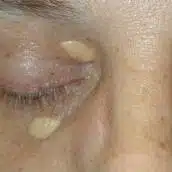
The appearance of a Xanthelasma is a yellow or white flat plaque or spot over the upper or lower eyelid, most often near the inside of the eye. They are made up of cells, that eat up blood fats. A Xanthelasma is therefore essentially a fatty cholesterol deposit around the eye. They do occur in other parts of the body, but they would then be called Xanthoma.
How can a Xanthelasma be removed?
Please read the contents of this site very carefully and also watch the video. It is very important you understand all the Xanthelasma related information so you can make an informed choice and you understand the pros and cons of removal and different removal methods
Different terms for Xanthelasma = Xanthoma = Cholesterol on eyelid = Fatty Deposit Eyelid = Fatty Lump around the eye = White Spot around the eye = Eye Cysts = Yellow marks on eyelid = Yellow eyelids = Yellow eyelid marks = Yellow Eyelid Bump
How Can I Self Diagnose A Xanthelasma?
The appearance is usually beyond doubt, because there are not many other known conditions causing yellow plaques in the same areas. Another small tumour around the eyes called Syringoma can sometimes be confused with it. Sometimes there can also be cysts which look similar although they tend to be bulkier.
Who gets Xanthelasma?
They occur a little more often in women than in men and the peak incidence is in the fourth to fifth decades. There have been some publications about Xanthelasma running in families and being related to high blood fats, but there is no conclusive evidence.
How can I prevent Xanthelasma growing bigger or re-forming after removal?
The answer is we don’t know. There is some evidence that lowering your blood fats by loosing weight, taking cholesterol lowering tablets or changing your diet would directly affect the Xanthelasma, but as it makes good common sense to do so anyway you may wish to consider this.
Do they get bigger?
Once the Xanthelasma is established, it tends to remain the same size or grow slowly; it definitely does not go away by itself. Your eyelid function will generally not be affected and drooping of the eyelid is rare. Because of their tendency to grow it is better to treat them early if you are concerned about your appearance. But the treatment does not always arrest growth and patients sometimes have to come back from time to time for more treatment.
Anything else I need to look out for?
Yes, you need to get your blood fats checked by your doctor and do a risk assessment for your heart and blood vessels.
What Can Thames Valley Surgical Services Do For Me?
Scarring
A habit to return…
Option 1: Microcautery = Electrodessication (fast and quick, 80% improvement, cheaper)
For most Xanthelasmas we use Electrodessication (Microcautery). This treatment causes less scarring than cryotherapy (freezing) and is less dangerous than chemical treatments to the eye. Most patients find that the resulting scar looks significantly better than the yellow plaques. You will experience an 70-90% improvement. And treatment is quick and requires no suture removal. This treatment is particularly helpful for anxious patients, who want a quick and uncomplicated treatment.
Please note, repeated treatments incur repeated costs and while 90% of patients walk out with the cost as outlined on this page, there are some, who will have to have one or more repeat treatments. We do offer a 50% “no profit” discount on 2nd or 3rd treatments, but we are a private clinic and have to charge you our costs. And if after your treatment you still require a cutout of the scar or the remaining Xanthelasma then there is an additional cost.
Option 2: Full surgical removal of Xanthelasma (better result i.e. 95% improvement and very fine line often invisible scar)
This option is limited to patients with small to medium size Xanthelasmas (they can be long, but not too large in diameter) because removing too much of the eyelid tissue may leave the skin too tight. It is also usually limited to older patients because young patients with taut skin could experience problems after the surgery (eyelid too tight).There needs to be enough excess / redundant skin for this option. Furthermore, if the stitches come apart (swelling i.e. due to hayfever, rubbing, allergy, infection etc) a worse scar than with the electrodessication can result, deeper and you have already removed part of the eyelid, so secondary scar removal may then not be easily possible. Finally, the shape of the eyelid can discreetly change due to the skin you cut away on one side, but not the other. Mostly in older patients this will stretch out, but may be a problem on younger patients.
Prior to surgery we will give you a local anaesthetic, usually via injection.
Cost of Xanthelasma Removal: from £275*
Electrodessication = Microcautery of Xanthelasma
The cost of removal for Fatty Cholesterol Deposits around the eye (Xanthelasma) starts at £275* for one eyelid and £75 for every further eyelid, regardless of the size of the Xanthelasma. This does not include the consultation. For further price guidance click here
Furthermore, if you need a second or third treatment within 3 months of the first treatment we will provide this at 50% of the initial cost (i.e. say you had 2 Xanthelasmas for £410, you will pay £205 for a second treatment)
Full surgical removal of Xanthelasma:
Full cutouts are priced at £495 (£435 once consultation discount applied*) for the first Xanthelasma and £295 for every further Xanthelasma up to 2cm. More extensive Xanthelasmas are more expensive (but not hugely so). There are no discounts for further procedures because any further procedure is due to the natural re-occurence of Cholesterol in a new different area (which was not cut out).Xanthelasma stitches are very small and therefore harder to remove (not impossible). Stitch removal is therefore included in this price. However, we can, for the brave, also give you a free stitch removal kit or if you live far away your GP nurse may be able to help.
* consultation discount of £60 has been applied in this price
Make an appointment
To make an appointment you can contact us or book a clinic appointment online. Alternatively you can ask for a telephone appointment. If you do so, please read the section “How TVVS works”, thoroughly. In case you are worried about pain, please click here to see how we provide painfree surgery.
More Information: For a glossary on minor surgery terms, click here
For more infomation about Lipomas look at patient.info
Accessibility Information: Locations Appropriate for Referral or Treatment:
We provide Minor Surgery / Skin Surgery for Lipomas, Cysts, Warts, Moles, Skin Tags, Xanthelasmas and Split Earlobes in Maidenhead, Berkshire, which is near Windsor and Ascot and Heathrow Airport and close to London, South Buckinghamshire, South Oxfordshire, Hampshire and Surrey. TVSS are adjacent to Henley-On-Thames, Marlow, and Twyford. Also, we are close to Slough, Bracknell, Basingstoke, Egham and Gerrards Cross. Chalfont St Peter, Northolt, Harrow and Wembley. Rickmansworth, Richmond, Twickenham, Staines and Virginia Water. Sunningdale and Sunninghill, Ruislip, Reading, Wokingham and West Drayton. Uxbridge, Farnborough, Woking, Guildford. Oxford, Banbury, Milton Keynes and Coventry. Essex, Sussex, Kent, Swindon, Portsmouth and Bristol, Bath, Brighton, Eastborne and Southhampton are all no more than an 45 minutes to 2 hours away. Via the M4 we are also accessible to certain locations in South Wales
Example of Electrodessication Treatment
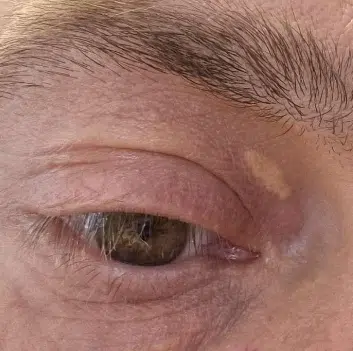
Xanthelasma in 47 year old patient
Upper eyelid of a 47 year old gentleman with a Xanthelasma. Dr Kittel saw him in January 2022 to treat him with Electrodessication treatment.
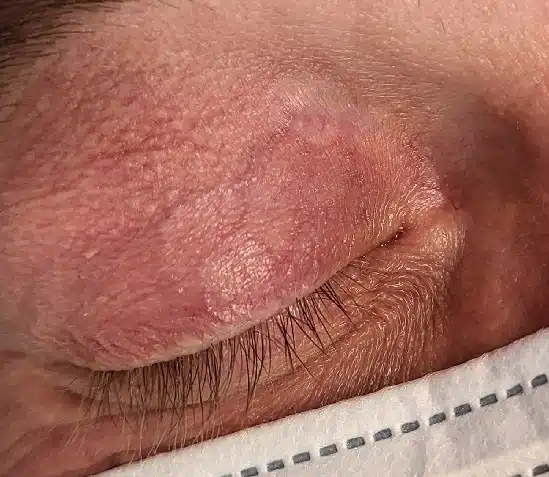
After Electrodessication Treatment
This is the scar remaining after Electrodessication treatment and this represents a typical scar. Some people have better scars, some are worse. Scars can sometimes be stronger, more pronounced or taking longer to heal. They also tend to be pink to start and then get whiter. If you pick them (the initial scabs) or they get infected, they may be worse. I saw him for repeated treatment of his other eyelid, see below. Note, the right lower eyelid had also been treated and had healed well, too, but is under the mask.
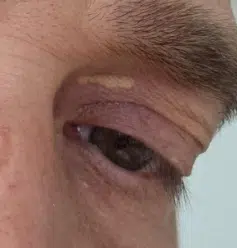
Same man left eyelid before treatment
This is the left upper eyelid of the same man. Dr Kittel treated his left upper eyelid in January too.
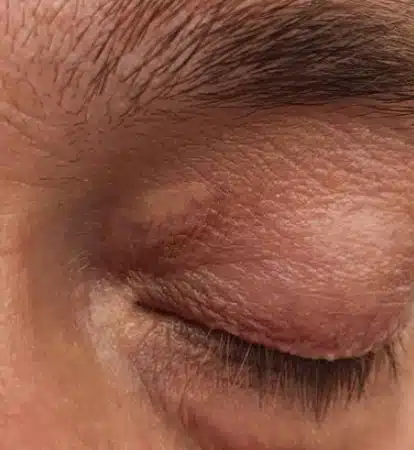
After 1 Xanthelasma treatment with Electrodessication – not fully resolved
The left upper eyelid had not fully resolved. At a distance the Cholesterol is already much less yellow (as only deeper Cholesterol remains), but it is not ideal. This man came for a second treatment of the left upper eyelid at 50% of the cost. The right upper eyelid (see above) and the right lower eyelid (hidden by mask above) were as good as we can get them and the patient was happy with the outcome.
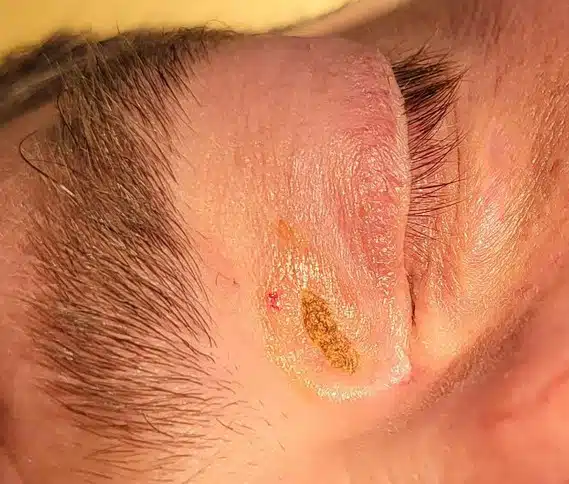
This is a typical picture right after Electrodessication (this is the same patient as the 4 pictures above).
The swelling on the eyelid is the local anaesthetic. The bloody dot in the left upper corner is from the injection. The remaining Xanthelasma was fully treated and covered in brown iodine (to prevent infection). Subsequently the iodine is dried away. Within 2 days a scab will form and when the scab falls off you will know whether or not the treatment was successful. In this case Dr K had to choose a slightly higher energy setting to get the deeper layers and destroy the remaining Cholesterol. I will try to post further pictures when they become available.
Example of Excision Treatment 1
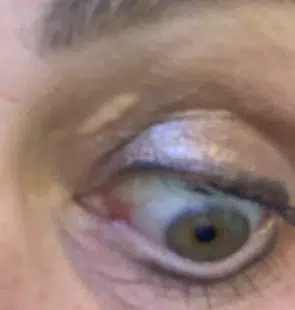
Xanthelasma in a 55 year old lady
This is the left upper eyelid of a 55 year old caucasian lady before treatment
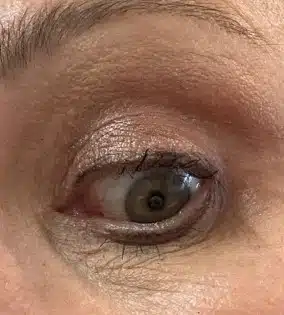
6 months after full excision of Xanthelasma
This is a picture of the same left eye of the lady above 6 months after full excision of the Xanthelasma in March 2023 – see comment below
Scar is covered with make up
If you look carefully, there is actually a small scar in this lady. This scar is very discreet and can easily be covered with make up, but I thought it worthwhile pointing out for complete transparency.
Example of Excision Treatment 2
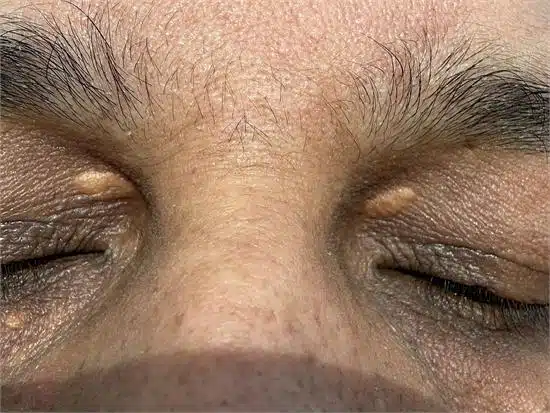
Upper eyelid Xanthelasma in Asian Gentleman
Both upper eyelids in a 53 year old asian gentleman before excision of the Xanthelasmas. I tend to recommend full excision to asian patients, because their Xanthelasmas tend to go deeper and the discolouration from the Electrodessication method is more visible.
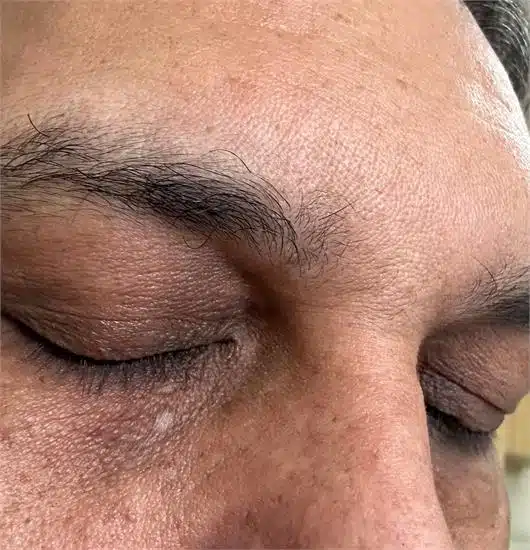
6 weeks after excision
This is a picture of the same gentleman 6 weeks after excision. In fact he had the stitches on the left coming apart a little during recovery, yet still showed excellent healing. I often advise asian patients to start a Cholesterol tablets after excision.
Example of Excision Treatment 3
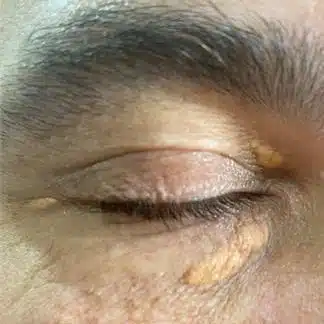
Xanthelasma before excision in 45 year old
This is the right upper eyelid of a 45 year old caucasian gentleman. He came and saw us in December 2022.
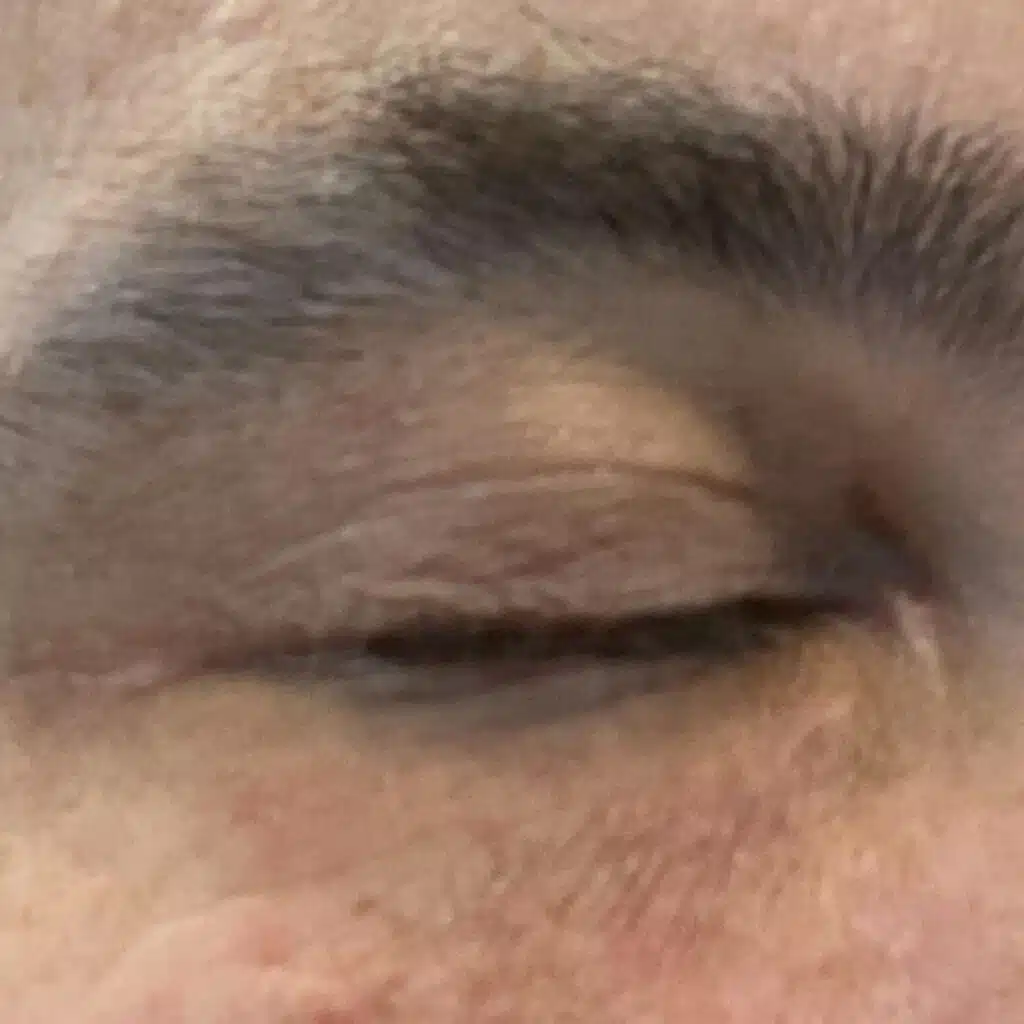
Scars 3 months after Xanthelasma excision
These are the scars remaining after excision of of all 3 Xanthelasmas excactly 3 months later in March 2023
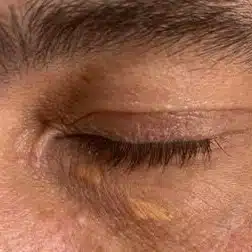
Xanthelasma left eyelid
This is the left upper eyelid of the same man. You can see 2 Xanthelasmas on the lower eyelid, but also a few spots / milia, which we treated with Electrodessication
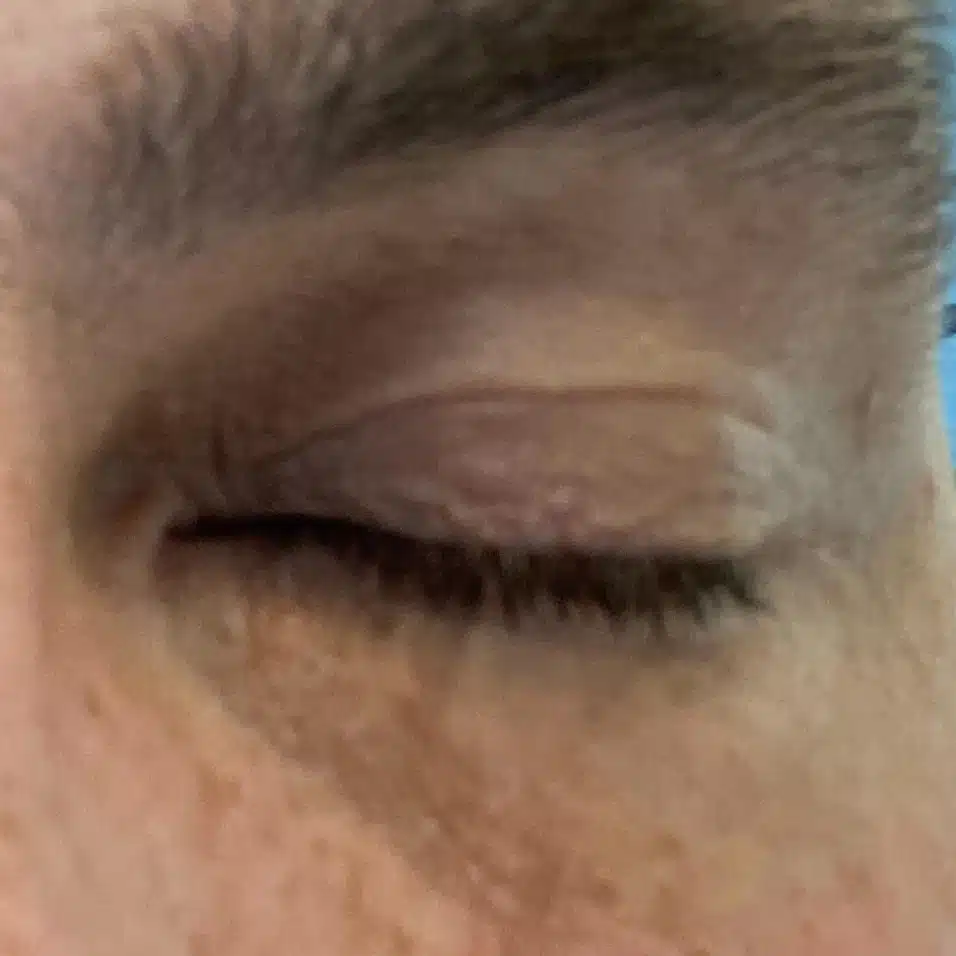
Left upper eyelid 3 months after Xanthelasma and milia treatment
This is the same man 3 months after completion of treatment. Overall he wrote to me how happy he was
Excision vs Electrodessication
| Excision | Electrodessication |
Price | Higher | Lower |
Speed | Takes time | Very quick |
Second procedure due to incomplete removal within 4 | Uncommon | 5-10% |
Improvement in looks (typical, not an individual | 95% | 80% |
Possible in under 45 year old | Not usually, unless very small | Yes, but satisfaction with the outcome cannot always be guaranteed. Not good for patients with darker skin. |
Stitches needed | Yes | No |
Chance of stitches coming apart | Yes | No |
Stitch removal needed | Yes | No |
Second procedure within 3 months (incomplete removal | No | Yes |
Guarantees Xanthelasma will not return | No | No |
Chance of significant bruising and bleeding | <5% | <1% |
Patient dissatisfaction | 2% | 8% |
Type of scar | Fine line | Same size as previous Xanthelasma |
Typical pain in recovery | Minor | Minor |
Recommended in darker skinned patients | Yes | It depends |
Recommended in lighter skinned patients | Yes | Yes |
Summary of our experience with Xanthelasma patients over the years:
No Xanthelasma treatment is perfect. In Electrodessicatoin we have to go slowly and start with low energy settings to not damage the eyelid. this means, some patients have to return.
We see a good number of patients that have been to other services and had no success with a treatment.
An alternative treatment we do not offer is the treatment with Tricloracetic Acid, the most common side effect here is hypopigmentation of the skin and you are more likely to need repeat treatments. See here: https://pubmed.ncbi.nlm.nih.gov/19617785/
It is very important that your expectations are realistic. It is also important you understand that new Cholesterol can form. If it forms within the scar it is usually speckled and previous treatment can often be recognised. The stronger the scar the less likely Cholesterol will settle within it, it tends to settle within non-scarred areas. Occasionally, it also settles in areas around the area previously treated.
If your scar is more prominent it is very important to be patient and wait for up to 2 years as well as do the aftercare interventions we recommend to you to minimise scarring. Many scars will get better and better over time and slowly contract and turn from pink to white.
Who is more likely to be unhappy with the outcome
In our experience the least likely patients happy with the outcome is young women (sometimes exacerbated by mental health conditions like depression), whose confidence is extremely affected by the Xanthelasma and / or who want a perfect result. This is particularly the case if the scar is not settling as quickly as they hoped to. We would recommend ladies under 45 years of age with taut skin to be very careful before choosing any service or any treatment including our service.
Another group of patients that is sometimes not so happy are more dark skinned patients, who choose the Electrodessication method. We often find that Cholesterol in dark skinned patients is deeper located and often recommend excision in those patients. A scar in dark skinned patients can be lighter and the contrast higher compared with surrounding skin. Also darker skinned patients have a higher return rate for Cholesterol due to their underlying genetics and it is even more important to look at Cholesterol lowering measures wherever possible.
Who is likely to be happy with the outcome?
The large majority of patients are very happy with the outcome. Women often prefer a scar as it is easier to cover with make up than the bright yellow Cholesterol. Men tend to prefer it, because men often do not worry about scars as much than about the bright yellow signal colour of cholesterol in the eyelid (no a universal truth, but a common one). Generally the face is a region that is exposed to air and weather and tends to heal well. For example a man shaving and cutting himself does not usually end up with a permanent scar.

